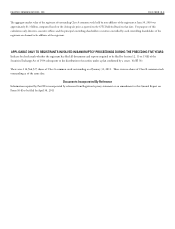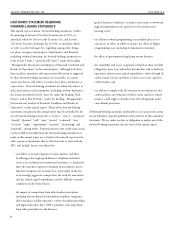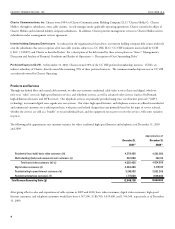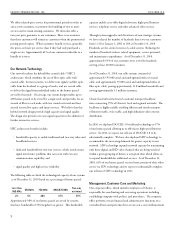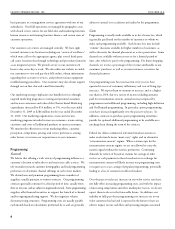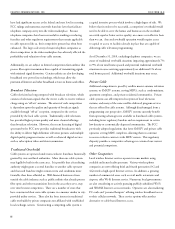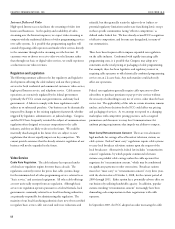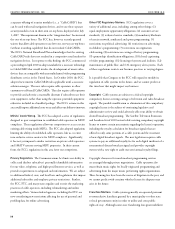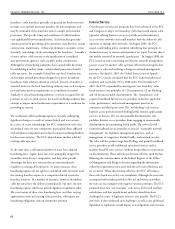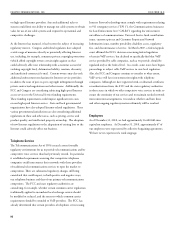Charter 2010 Annual Report Download - page 21
Download and view the complete annual report
Please find page 21 of the 2010 Charter annual report below. You can navigate through the pages in the report by either clicking on the pages listed below, or by using the keyword search tool below to find specific information within the annual report.
basis pursuant to a management services agreement with one of our
subsidiaries. Our field operations are managed by geographic areas
with shared service centers for our field sales and marketing function,
human resources and training function, finance, and certain areas of
customer operations.
Our customer care centers are managed centrally. We have eight
internal customer care locations including our “centers of excellence”
which route calls to the appropriate agents, plus several third-party
call center locations that through technology and procedures function
as an integrated system. We provide service to our customers 24
hours a day, seven days a week. We also utilize our website to enable
our customers to view and pay their bills online, obtain information
regarding their account or services, and perform various equipment
troubleshooting procedures. Our customers may also obtain support
through our on-line chat and e-mail functionality.
Our marketing strategy emphasizes our bundled services through
targeted marketing programs to existing and potential customers
and increases awareness and value of the Charter brand.Marketing
expenditures increased by $14 million, or 5%, over the year ended
December 31, 2009 to $286 million for the year ended December
31, 2010. Our marketing organization creates and executes
marketing programs intended to increase customers, retain existing
customers and cross-sell additional products to current customers.
We monitor the effectiveness of our marketing efforts, customer
perception, competition, pricing, and service preferences, among
other factors, to increase our responsiveness to our customers.
General
We believe that offering a wide variety of programming influences a
customer’s decision to subscribe to and retain our cable services. We
rely on market research, customer demographics and local programming
preferences to determine channel offerings in each of our markets.
We obtain basic and premium programming from a number of
suppliers, usually pursuant to written contracts. Our programming
contracts generally continue for a fixed period of time, usually from
three to ten years, and are subject to negotiated renewal. Some programming
suppliers offer financial incentives to support the launch of a channel
and/or ongoing marketing support. We also negotiate volume
discount pricing structures. Programming costs are usually payable
each month based on calculations performed by us and are generally
subject to annual cost escalations and audits by the programmers.
Costs
Programming is usually made available to us for a license fee, which
is generally paid based on the number of customers to whom we
make such programming available. Such license fees may include
“volume” discounts available for higher numbers of customers, as
well as discounts for channel placement or service penetration. Some
channels are available without cost to us for a limited period of
time, after which we pay for the programming. For home shopping
channels, we receive a percentage of the revenue attributable to our
customers’ purchases, as well as, in some instances, incentives for
channel placement.
Our programming costs have increased in every year we have
operated in excess of customary inflationary and cost-of-living type
increases. We expect them to continue to increase, and at a higher
rate than in 2010, due to a variety of factors including amounts
paid for retransmission consent, annual increases imposed by
programmers and additional programming, including high-definition
and OnDemand programming. In particular, sports programming
costs have increased significantly over the past several years. In
addition, contracts to purchase sports programming sometimes
provide for optional additional programming to be available on a
surcharge basis during the term of the contract.
Federal law allows commercial television broadcast stations to
make an election between “must-carry” rights and an alternative
“retransmission-consent” regime. When a station opts for the
retransmission-consent regime, we are not allowed to carry the
station’s signal without the station’s permission. Continuing
demands by owners of broadcast stations for carriage of other
services or cash payments to those broadcasters in exchange for
retransmission consent will likely increase our programming costs
or require us to cease carriage of popular programming, potentially
leading to a loss of customers in affected markets.
Over the past several years, increases in our video service rates have
not fully offset increasing programming costs, and with the impact
of increasing competition and other marketplace factors, we do not
expect them to do so in the foreseeable future. In addition, our
inability to fully pass these programming cost increases on to our
video customers has had and is expected in the future to have an
adverse impact on our cash flow and operating margins associated


